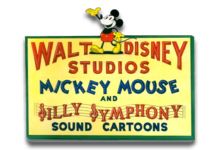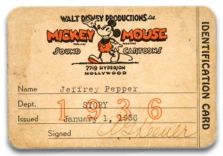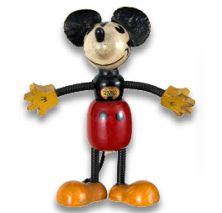
Among many Disney historians and enthusiasts, it is legend. A time and place now far removed, but distinct in memory, awash with nostalgia and rich with irony. For a little over a decade, it was not just a simple souvenir shop within the happiest place on earth, but also a small but ever so significant bridge of connectivity between studio and theme park. It brokered the sales of enchantment on acetate, and in doing so, likely preserved countless tangible pieces of animation history that might have otherwise met with incineration. Many future animation professionals left this special store carrying inspiration in a paper bag, ensuring a subtle yet enduring legacy heretofore largely uncelebrated.
The Disneyland Art Corner was indeed a place of magic.

This souvenir store, nestled in a corner of Tomorrowland, was born with Disneyland in 1955 and serviced park guests until shuttered in September of 1966. It began as a temporary location in a striped tent just off the hub near the Red Wagon Inn, when Disneyland opened on July 17, 1955. After work on Tomorrowland was completed later that summer, the Disneyland Art Corner opened there in a new, permanent location on September 5, 1955. The interior of the store featured a Paris-inspired theme, appropriate enough for its art-based atmosphere, but clearly an odd fit for its Tomorrowland setting.

The
if I only had a time machine . . . scenario is a daydream common to almost everyone. In that regard, it would be no understatement to suggest that the Art Corner would likely be the favorite temporal destination of most Disneyana collectors and enthusiasts. Among its many products were postcards, flip books, artist prints, art supplies, animation kits and various other sundry souvenirs. But most famously, this was the place where original hand-painted animation cels and cel elements could be purchased for as little seventy-five cents a piece.

Disney historian Jim Korkis remembers, "There was nothing else like Disneyland in the entire world when I was a kid. So it was not unusual to me that there was nothing else like the Disneyland Art Corner in the entire world." Korkis visited the Art Corner frequently as a child in the mid-1960s. He recalls, "There, in Tomorrowland, in a square building near a fenced off area where model airplanes buzzed loudly, was the Disneyland Art Corner. Part of the building was devoted to a display of how animation was done. Apparently, it was part of a traveling display that had toured in connection with the release of Sleeping Beauty as well as some items that Walt had shown on his weekly television program. They even had thaumatropes displayed! I remember walking through the exhibits, reading the explanatory plaques next to the displays and trying to figure out how it all worked." This was the Art of Animation exhibit that was adjacent to the Art Corner in the same building and opened in May of 1960.
Of the Art Corner itself, Korkis remembers much of the store's merchandise. "The majority of items were 'gag' items including postcards featuring Disney characters but with a 'squeaker' inside, flicker buttons where a picture of Goofy with a slight tilt would proclaim
I’m Goofy About Disneyland or a picture of Tinker Bell who would state
I Tink Disneyland Is Great, or funny signs, or small little colored plastic television sets that when you looked through a small white hole in the back of the set and pulled a switch on the side a cartoon picture would rotate."

A 1956 mail order catalog for the Art Corner described much of the shop's mainstay merchandise. Among the more unique items:
WALT DISNEY CARTOON CHARACTER GUIDES
These 16-page guides contain the actual model sheets used by the artists at the Walt Disney Studios in drawing the various Disney characters. Each book covers all the proportions positions, and characteristics of one particular character. An invaluable source of information for the budding, young artist. Library now available:
"How to Draw Mickey Mouse"
"How to Draw Donald Duck"
"How to Draw Jiminy Cricket"
"How to Draw Goofy"
"How to Draw Pluto"
"How to Draw Chip and Dale"
1.16 each
 ART CORNER, DISNEYLAND POST CARDS
ART CORNER, DISNEYLAND POST CARDS
A set of eight souvenir Disneyland post cards in full color featuring Donald Duck. Mickey Mouse, Lady and Tramp, and other well known Walt Disney characters. These cards were designed by the artists at the Walt Disney Studios in Burbank and are sold exclusively through the Art Corner, Disneyland. A lot of fun to mail them to your friends from your own home town.
.45 per set of eight
WALT DISNEY FLIP BOOKS
See your favorite WALT DISNEY characters come to life. A wonderful toy as well as an excellent demonstration of the principles of animation. Each book has a full color cover and contains thirty pages of black and white sequence drawings. Now available:
Mickey Mouse
Donald Duck
Pluto
Chip and Dale
.24 each . . . .90 set of four
ARTISTS SOUVENIR PALETTE WITH WATER COLORS
A large palette with simulated wood grain, complete with brush and six genuine water color cakes. Also imprinted with the ART CORNER Mickey Mouse sending greetings from Disneyland.
.34 each
The Art Corner sold a wide variety of art supplies, from easels and pens to paints and sketch pads. One of the store's most notable products was this one:
 WALT DISNEY ANIMATION KIT
WALT DISNEY ANIMATION KIT
This kit is the result of considerable research and experimentation by the artists at the Walt Disney studio and is designed for anyone who likes to draw and has an aptitude for cartooning. It is complete in every detail and contains the following: One Animation Board complete with sides, glass, standard pages, and instructions for assembly and installation of light, two 16-page character model guide books using Walt Disney characters, one "Tips on Animation" book, one glossary of animated terms, one hundred sheets of high grade punched animation paper, two pencils, one eraser, six standard exposure sheets, and seven page treatise on animation methods at the Walt Disney Studio.
7.70 West of the Rockies
8.20 East of the Rockies

The Walt Disney Animation Kit was an inspiring piece of merchandise to many young artists of the era. Jim Korkis remembered the impact it had on him as an aspiring young animator. "There was even the offer that if you did an animated scene you could send it to the Art Corner and they would film it in 8mm and send it back to you!" Korkis recalls. "In addition, you got a special card declaring you a member of the Art Corner. At the time, to me, that was as good as being told I was a Disney animator."
Animation professional and filmmaker Michael Sporn also has fond memories of the kit. Sporn recollects, "I used that light box for many years animating lots of 8mm film. That kit probably solidified my desperate desire to get into animation when I was a kid." Veteran animator Tom Roth, who has worked on such films as
Rescuers Down Under,
Hercules,
Dinosaur and
Shrek, remembered, "I did a couple of pencil tests and sent them onto the Disney studio to be shot. They sent them back with a nice letter saying my animation was the best they had seen from all the Animation Kit owners. That got me started and I have been a professional animator now for 36 years."
But most significant of all the listings in the catalog was this one:
WALT DISNEY ORIGINAL CELLULOID DRAWINGS
Walt Disney "originals," are hand inked and painted in full vivid color, and mounted on heavy colored 9"x12" matboard ready for framing. Not copies, transfers or duplicates of any kind, but the actual hand-drawn artwork used in photographing a recent Walt Disney picture. These beautiful pictures are a most appropriate souvenir of Disneyland. Ideal for children's rooms. Now available are Lady and the Tramp and some other characters from this feature. Also, Goofy, Donald Duck, Chip and Dale, Humphrey the Bear, and Jiminy Cricket, from recent Disney pictures. Please specify your preference, but order is subject to stock on hand.
1.47 complete with souvenir mailing envelope
Yes, that's right. $1.47.

Rob Richards, perhaps best known as the house organist at Disney's El Capitan Theatre, is a fifteen year veteran of collecting animation art and Disneyana. He states that, " . . . the Art Corner has a legendary, almost mythological status. I can't imagine the
lottery win of buying original Disney production cels for a dollar!" Richards has become a scholar of animation art and collecting, and something of an expert when it comes to the Disneyland Art Corner. According to Richards, the Disney Studio didn't generally ascribe much value to their cels. "They were just a step in the production process. Frank Thomas told the story of taking home cels from
Fantasia so his kids could use them to slide down the neighborhood hill! Many cels were simply thrown away after being photographed."
The Art Corner was however, not the first time Disney made animation art available for purchase. Richards notes, "Through the years, Disney realized the artwork did indeed have some historic and commercial value and could generate some income for the studio. The first cel marketing venture included 7000 cels from
Snow White, released by San Francisco's Couvoisier Gallery. These were followed by cels from
Pinocchio,
Fantasia,
Dumbo, the Silly Symphonies, etc. These originally sold for $5 to $50, a fairly expensive price in those post-Depression years. For five dollars, a person could buy a single cel set-up over a simple airbrush background. For $50, one purchased a more elaborate, panorama or multi-character piece. The Courvoisier Gallery sold these early Disney cels for roughly ten years, at what were considered rather high prices for the day. In 1948, the Courvoisier Gallery went out of business."
The business of selling cels was given new life when Disneyland opened in 1955. This was due almost entirely to the efforts of Jack Olson, a background artist at the Disney Studio who was placed in charge of the studio's retail venues within the park. Olson literally rescued thousands of cels from awaiting garbage dumpsters and turned them into revenue-generating Disneyland souvenirs.
"These Art Corner animation cels were sold at an astonishing low cost," says Rob Richards. "I have one piece actually hand-priced in pencil on the back... 75 cents! The usual price was a dollar for a single character, up to five dollars for a multi-cel setup." In their book
Disneyland: The Nickel Tour, authors Bruce Gordon and David Mumford observed, "They were considered of such little value, in fact, that Disney designer Malcolm Cobb was told to sort through the cels, and throw away any he thought weren't worth a dollar."
 An Art Corner cel of Chip and Dale, likely from a
An Art Corner cel of Chip and Dale, likely from a
television production, on an unrelated background.
From the collection of Bob Cowan.
Rob Richards described some of the distinctive hallmarks of Art Corner cels. The cels were usually trimmed (sometimes drastically), reduced in size from a full cel sheet to as small a piece as possible. Small mats were less expensive, increasing the per-piece profit margin. The cel layers were stapled to color print backgrounds reproduced from Disney animated films, or just as often over a piece of plain colored art board. The finished setups were overlaid with a blank cel for protection. On occasion the mostly-blank overlay cel was a remnant of an effects cel. Setups were fitted with an inexpensive mat, and the backing was taped shut with plain old masking tape. The finishing touch was the "Gold Seal." Applied to the back of the cel, it stated
This is an original handpainted celluloid drawing actually used in Walt Disney production, released exclusively at Disneyland © copyright Walt Disney Productions.

Richards also explained that one of the bewildering, but still amusing aspects of Art Corner setups was the odd combinations. "You might get a cel of a penguin from
Mary Poppins coupled with Donald Duck from an industrial or educational film, on a background from
Paul Bunyan! Or Tinkerbell and one of Donald Duck's nephews on a
Sleeping Beauty background. These are actual setups I've had. The bizarre combinations were endless."
Richards notes that it is impossible to overestimate the importance of the Art Corner. "The Art Corner rescued thousands of cels from being destroyed and saved them for posterity."
A number of Disney Studio artists frequented the Art Corner, drawing sketches and creating caricatures for park guests. Studio veteran and Mouseketeer Roy Williams made numerous appearances there throughout the late 1950s and early 1960s.
Though the Disneyland Art Corner closed in 1966 to accommodate a dramatic overhaul of Tomorrowland the following year, its retail legacy lives on to some extent in the Art of Disney stores scattered throughout Disneyland and Walt Disney World. But it is a legacy that has certainly lost the innocence of that earlier era. Ironically, the Art Corner's inexpensive but authentic pieces have been replaced by collectible reproductions priced in the hundreds to sometimes thousands of dollars.
What remains of the Disneyland Art Corner are simple memories of joy, discovery and inspiration. It was a place that, for eleven very short years, encapsulated the creative spirit and heritage that was ultimately responsible for the very theme park that surrounded it.
Special thanks to many individuals who have generously shared their resources relating to the Disneyland Art Corner: Jim Korkis, Rob Richards, Bob Cowan, Jenny Lerew, Hans Perk and the blog Vintage Disneyland Goodies.
Disneyland Art Corner postcards provided courtesy of disneylandpostcards.net.
 The one panel comic Private Lives was similar to the more famous Ripley's Believe It or Not! and focused on little known facts about famous figures and personalities. This particular edition of the comic was published on May 17, 1939 and spoke of General Francisco Franco's somewhat ironic fascination with Mickey Mouse.
The one panel comic Private Lives was similar to the more famous Ripley's Believe It or Not! and focused on little known facts about famous figures and personalities. This particular edition of the comic was published on May 17, 1939 and spoke of General Francisco Franco's somewhat ironic fascination with Mickey Mouse.






























































